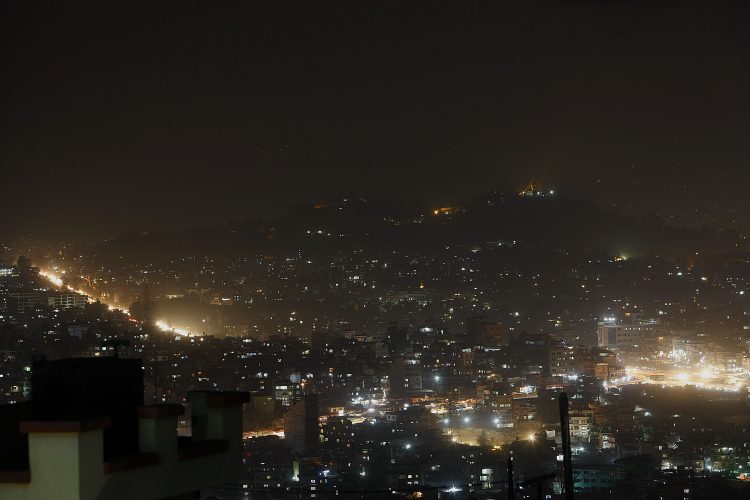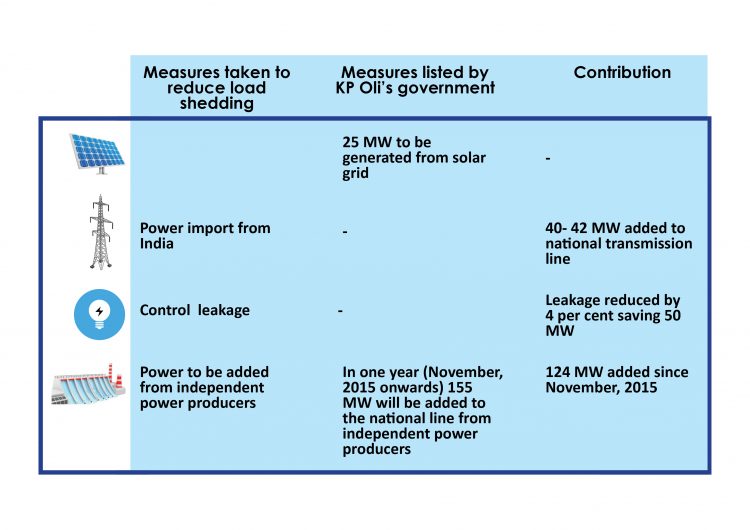Who should be credited for ending load-shedding?
Bhrikuti Rai / March 17, 2017

Swayambhu and Kalanki area seen from Kirtipur recently. Photo: Bikram Rai
Speaking at a function held to welcome the new entrants to the CPN-UML on February 26, 2017, party chairman and former prime minister KP Sharma Oli said that the load-shedding ended as per the work plan made by his government. He also added that the current government was merely taking the credit for the same work.
South Asia Check has examined the claim by comparing the white paper issued by Oli-led government on November 24, 2015 that discusses load-shedding with the actual steps taken recently to cut load-shedding.
Following are some of the points listed under the sub-heading energy security in the white paper:
Construction of Upper Tamakoshi, Kulekhani 3, Chameliya hydro power projects will move ahead aggressively. Twenty-five megawatts (MW) will be added from grid solar project, and similar projects that will add 200 MW to the national transmission line will be pushed forward. Provisions will be made to add 155 MW to the national transmission line from private hydropower projects.
In the last one year the following progress was made in the points listed in the white paper:
Solar energy: Unlike what was mentioned in the white paper, the 25 MW solar project is far from being complete. According to the World Bank (which has funded the project) the entire process (including bid evaluation and contract award) has been delayed by 18 months and Nepal Electricity Authority will finish evaluating the shortlisted bidders for the project by the end of March.
Power addition: Nepal’s peak electricity demand is around 1300 MW. According to NEA spokesperson, the contribution of independent power producers to the national grid was 325 MW until the end of last fiscal year. Since the beginning of the new fiscal year, that number has risen to 450 MW with 105 MW added in the last nine months. Because of the earthquake, the much-awaited 456 MW Upper Tamakoshi Hydropower project couldn’t be completed in the last one year.
Import from India: Nepal had imported 345 MW from India in the last fiscal year. This year Nepal imported an additional 40-42 MW from India. While the white paper issued by KP Oli-led government doesn’t list importing power from India as one of the ways to reduce the load-shedding, the additional import has helped in cutting down the load-shedding.
The beginning of the end of load-shedding
Kathmandu Valley saw sharp fall in load-shedding hours from last November. Talking to Naya Patrika newspaper, NEA’s Managing Director Kulman Ghising listed the following things that helped NEA reduce load shedding.
“We use all the big plants in the evening and have made efforts to manage plants like Kaligandaki, Marsyangdi and Trishuli.
“All of this is about the optimization of system operation. We store water in these plants so that maximum power can be generated during the peak hours. Kali Gandaki can generate 90 MW during the day time and 140 MW in the evenings. We use the plant less in the day so we can meet in the demand in the evening.
“We have also cut power supply to industries in the evening for about 3 -4 hours.
“When the load-shedding hours came down, so did the use of inverters. This has helped us save nearly 100 MW. Similarly we have made several efforts to control leakage.
“We have also managed power import as per our need. We can now import 250–300 MW from India. Since the infrastructures are the same we cannot import more electricity even if we want to. “
In addition to these, NEA spokesperson Prabal Adhikari also informed that the NEA was able to cut down leakage by nearly 4 percent which has helped NEA save 50 MW.

Grahpic: Bikram Rai
Most of the measures listed in the white paper prepared by KP Oli’s government to reduce load-shedding were not started or implemented in the last one year. However, of the targeted 155 MW of power, 124 MW from the independent power producers was added to the national grid in November, 2016. So KP Oli’s claim that the measures taken to reduce load-shedding since November is as per his government’s action plan is partially true.
This material is copyrighted but may be used for any purpose by giving due credit to southasiacheck.org.
Comments
Latest Stories
- In Public Interest Covid-19 cases are low, but that’s not an excuse to avoid vaccination
- In Public Interest What is BF.7, the sub-variant that has the world by its grip?
- In Public Interest Threat of a new Covid-19 wave looms large amid vaccine shortage in Nepal
- In Public Interest As cases decline, Covid-19 test centres in Kathmandu are desolate lot
- In Public Interest Dengue test fee disparity has patients wondering if they’re being cheated
- In Public Interest As dengue rages on, confusion galore about what it is and what its symptoms are. Here’s what you need to know
In Public Interest
 Covid-19 cases are low, but that’s not an excuse to avoid vaccination
The Pfizer-BioNTech bivalent vaccines authorised by the Nepal Government provide better protection a...
Read More
Covid-19 cases are low, but that’s not an excuse to avoid vaccination
The Pfizer-BioNTech bivalent vaccines authorised by the Nepal Government provide better protection a...
Read More
- What is BF.7, the sub-variant that has the world by its grip?
- Threat of a new Covid-19 wave looms large amid vaccine shortage in Nepal
- As cases decline, Covid-19 test centres in Kathmandu are desolate lot
- Dengue test fee disparity has patients wondering if they’re being cheated
- As dengue rages on, confusion galore about what it is and what its symptoms are. Here’s what you need to know